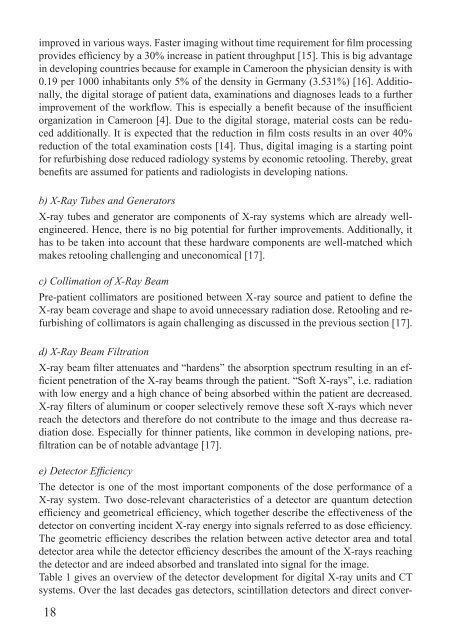Aspects of Green Hospital Approaches with a Focus on Developing ...
Aspects of Green Hospital Approaches with a Focus on Developing ...
Aspects of Green Hospital Approaches with a Focus on Developing ...
Sie wollen auch ein ePaper? Erhöhen Sie die Reichweite Ihrer Titel.
YUMPU macht aus Druck-PDFs automatisch weboptimierte ePaper, die Google liebt.
improved in various ways. Faster imaging <str<strong>on</strong>g>with</str<strong>on</strong>g>out time requirement for film processing<br />
provides efficiency by a 30% increase in patient throughput [15]. This is big advantage<br />
in developing countries because for example in Camero<strong>on</strong> the physician density is <str<strong>on</strong>g>with</str<strong>on</strong>g><br />
0.19 per 1000 inhabitants <strong>on</strong>ly 5% <str<strong>on</strong>g>of</str<strong>on</strong>g> the density in Germany (3.531%) [16]. Additi<strong>on</strong>ally,<br />
the digital storage <str<strong>on</strong>g>of</str<strong>on</strong>g> patient data, examinati<strong>on</strong>s and diagnoses leads to a further<br />
improvement <str<strong>on</strong>g>of</str<strong>on</strong>g> the workflow. This is especially a benefit because <str<strong>on</strong>g>of</str<strong>on</strong>g> the insufficient<br />
organizati<strong>on</strong> in Camero<strong>on</strong> [4]. Due to the digital storage, material costs can be reduced<br />
additi<strong>on</strong>ally. It is expected that the reducti<strong>on</strong> in film costs results in an over 40%<br />
reducti<strong>on</strong> <str<strong>on</strong>g>of</str<strong>on</strong>g> the total examinati<strong>on</strong> costs [14]. Thus, digital imaging is a starting point<br />
for refurbishing dose reduced radiology systems by ec<strong>on</strong>omic retooling. Thereby, great<br />
benefits are assumed for patients and radiologists in developing nati<strong>on</strong>s.<br />
b) X-Ray Tubes and Generators<br />
X-ray tubes and generator are comp<strong>on</strong>ents <str<strong>on</strong>g>of</str<strong>on</strong>g> X-ray systems which are already wellengineered.<br />
Hence, there is no big potential for further improvements. Additi<strong>on</strong>ally, it<br />
has to be taken into account that these hardware comp<strong>on</strong>ents are well-matched which<br />
makes retooling challenging and unec<strong>on</strong>omical [17].<br />
c) Collimati<strong>on</strong> <str<strong>on</strong>g>of</str<strong>on</strong>g> X-Ray Beam<br />
Pre-patient collimators are positi<strong>on</strong>ed between X-ray source and patient to define the<br />
X-ray beam coverage and shape to avoid unnecessary radiati<strong>on</strong> dose. Retooling and refurbishing<br />
<str<strong>on</strong>g>of</str<strong>on</strong>g> collimators is again challenging as discussed in the previous secti<strong>on</strong> [17].<br />
d) X-Ray Beam Filtrati<strong>on</strong><br />
X-ray beam filter attenuates and “hardens” the absorpti<strong>on</strong> spectrum resulting in an efficient<br />
penetrati<strong>on</strong> <str<strong>on</strong>g>of</str<strong>on</strong>g> the X-ray beams through the patient. “S<str<strong>on</strong>g>of</str<strong>on</strong>g>t X-rays”, i.e. radiati<strong>on</strong><br />
<str<strong>on</strong>g>with</str<strong>on</strong>g> low energy and a high chance <str<strong>on</strong>g>of</str<strong>on</strong>g> being absorbed <str<strong>on</strong>g>with</str<strong>on</strong>g>in the patient are decreased.<br />
X-ray filters <str<strong>on</strong>g>of</str<strong>on</strong>g> aluminum or cooper selectively remove these s<str<strong>on</strong>g>of</str<strong>on</strong>g>t X-rays which never<br />
reach the detectors and therefore do not c<strong>on</strong>tribute to the image and thus decrease radiati<strong>on</strong><br />
dose. Especially for thinner patients, like comm<strong>on</strong> in developing nati<strong>on</strong>s, prefiltrati<strong>on</strong><br />
can be <str<strong>on</strong>g>of</str<strong>on</strong>g> notable advantage [17].<br />
e) Detector Efficiency<br />
The detector is <strong>on</strong>e <str<strong>on</strong>g>of</str<strong>on</strong>g> the most important comp<strong>on</strong>ents <str<strong>on</strong>g>of</str<strong>on</strong>g> the dose performance <str<strong>on</strong>g>of</str<strong>on</strong>g> a<br />
X-ray system. Two dose-relevant characteristics <str<strong>on</strong>g>of</str<strong>on</strong>g> a detector are quantum detecti<strong>on</strong><br />
efficiency and geometrical efficiency, which together describe the effectiveness <str<strong>on</strong>g>of</str<strong>on</strong>g> the<br />
detector <strong>on</strong> c<strong>on</strong>verting incident X-ray energy into signals referred to as dose efficiency.<br />
The geometric efficiency describes the relati<strong>on</strong> between active detector area and total<br />
detector area while the detector efficiency describes the amount <str<strong>on</strong>g>of</str<strong>on</strong>g> the X-rays reaching<br />
the detector and are indeed absorbed and translated into signal for the image.<br />
Table 1 gives an overview <str<strong>on</strong>g>of</str<strong>on</strong>g> the detector development for digital X-ray units and CT<br />
systems. Over the last decades gas detectors, scintillati<strong>on</strong> detectors and direct c<strong>on</strong>ver-<br />
18




